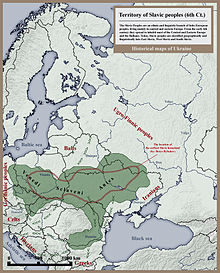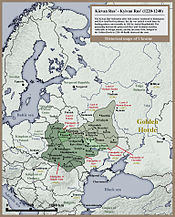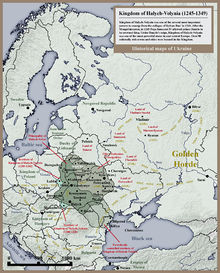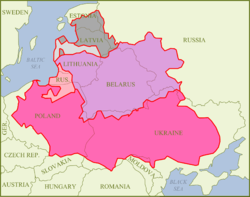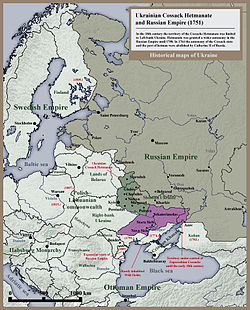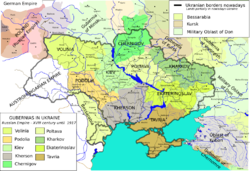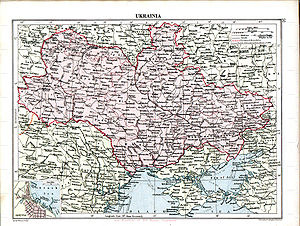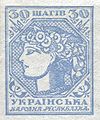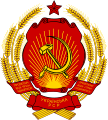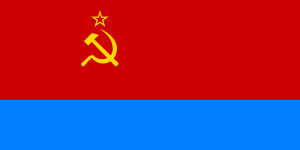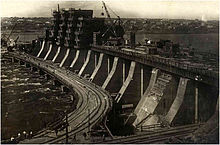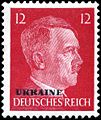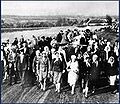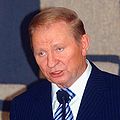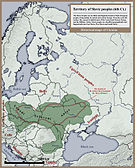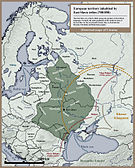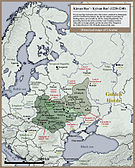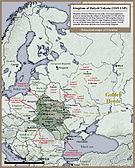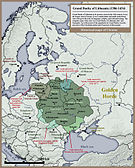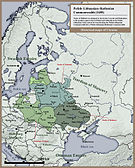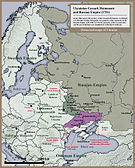- History of Ukraine
-
History of Ukraine 
This article is part of a series- Cassette Scandal
- Orange Revolution
- Russia–Ukraine gas disputes
The territory of Ukraine was a key center of East Slavic culture in the Middle Ages, before being divided between a variety of powers. However, the history of Ukraine dates back many thousands of years. The territory has been settled continuously since at least 5000 BC, and is also a candidate site of the origins of the Proto-Indo-European language family. The horse was first domesticated on the territory of Ukraine.[1][2][3]
Prehistory
See also: Ukrainian stone stelaHuman settlement in Ukraine has been documented into distant prehistory. Gravettian settlements dating to 32,000 BCE have been unearthed and studied in the Buran-Kaya cave site of the Crimean Mountains.[4][5] The late Neolithic Cucuteni-Trypillian Culture flourished from about 4500–3000 BC.[6] The Copper Age people of the Cucuteni-Trypillian Culture resided in the western part, and the Sredny Stog Culture further east, succeeded by the early Bronze Age Yamna ("Kurgan") culture of the steppes, and by the Catacomb culture in the 3rd millennium BC.
During the Iron Age, these were followed by the Dacians, Cimmerians, Scythians, Sarmatians, among other nomadic peoples. The Scythian Kingdom existed here from 750–250 BC.[7] Along with ancient Greek colonies founded in the 6th century BC on the northeastern shore of the Black Sea, the colonies of Tyras, Olbia, Hermonassa, continued as Roman and Byzantine cities until the 6th century AD.
In the 3rd century AD, the Goths arrived in the lands of Ukraine around 250–375 AD, which they called Oium, corresponding to the archaeological Chernyakhov culture.[8] The Ostrogoths stayed in the area but came under the sway of the Huns from the 370s. North of the Ostrogothic kingdom was the Kiev culture, flourishing from the 2nd–5th centuries, when it was overrun by the Huns. After they helped defeat the Huns at the battle of Nedao in 454, the Ostrogoths were allowed to settle in Pannonia.
With the power vacuum created with the end of Hunnic and Gothic rule, Slavic tribes, possibly emerging from the remnants of the Kiev culture, began to expand over much of the territory that is now Ukraine during the 5th century, and beyond to the Balkans from the 6th century.
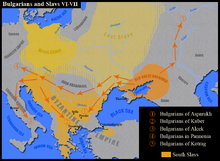 Old Great Bulgaria, VI-VII century
Old Great Bulgaria, VI-VII century
In the 7th century, the territory of modern Ukraine was the core of the state of the Bulgars (often referred to as Old Great Bulgaria) with its capital city of Phanagoria. At the end of the 7th century, most Bulgar tribes migrated in several directions and the remains of their state were absorbed by the Khazars, a semi-nomadic people from Central Asia.[8]
The Khazars founded the Khazar kingdom in the southeastern part of today's Europe, near the Caspian Sea and the Caucasus. The kingdom included western Kazakhstan, and parts of eastern Ukraine, Azerbaijan, southern Russia, and Crimea. Around 800 AD, the kingdom converted to Judaism.
Kievan Rus'
 Map of Kievan Rus' at its zenith (980–1054).
Map of Kievan Rus' at its zenith (980–1054).
 Map of Kievan Rus', 11th century.
Map of Kievan Rus', 11th century. Main article: Kievan Rus'
Main article: Kievan Rus'As Hrushevsky states, the city of Kiev was established during the time when area around the mid- and low-Dnipro was the part of the Khazar state. He derived that information from local legends because no written chronicles from that period are left. The main reasons for that might be the fact that during the Christianization of the Kievan Rus and later occupation of Ukraine, all earlier religious and historical publications of that land were destroyed. In 882, Kiev was conquered from the Khazars by the Varangian noble Oleg who started the long period of rule of the Rurikid princes. During this time, several Slavic tribes were native to Ukraine, including the Polans, the Drevlyans, the Severians, the Ulichs, the Tiverians, the White Croats and the Dulebes. Situated on lucrative trade routes, Kiev among the Polanians quickly prospered as the center of the powerful Slavic state of Kievan Rus.
In the 11th century, Kievan Rus' was, geographically, the largest state in Europe, becoming known in the rest of Europe as Ruthenia (the Latin name for Rus'), especially for western principalities of Rus' after the Mongol invasion. The name "Ukraine", meaning "in-land" or "native-land",[9] usually interpreted as "border-land", first appears in historical documents of 12th century[10] and then on history maps of the 16th century period.[11] The meaning of this term seems to have been synonymous with the land of Rus' propria—the principalities of Kiev, Chernihiv and Pereyaslav. The term, "Greater Rus'" was used to apply to all the lands ruled by Kiev, including those that were not just Slavic, but also Uralic in the north-east portions of the state. Local regional subdivisions of Rus' appeared in the Slavic heartland, including, "Belarus'" (White Ruthenia), "Chorna Rus'" (Black Ruthenia) and "Cherven' Rus'" (Red Ruthenia) in northwestern and western Ukraine.
Although Christianity had made headway into the territory of Ukraine before the first ecumenical council, the Council of Nicaea (325) (particularly along the Black Sea coast) and, in western Ukraine during the time of empire of Great Moravia, the formal governmental acceptance of Christianity in Rus' occurred at in 988. The major cause of the Christianization of Kievan Rus' was the Grand-Duke, Vladimir the Great (Volodymyr). His Christian interest was midwifed by his grandmother, Princess Olga. Later, an enduring part of the East-Slavic legal tradition was set down by the Kievan ruler, Yaroslav I, who promulgated the Russkaya Pravda (Truth of Rus') which endured through the Lithuanian period of Rus'.
Conflict among the various principalities of Rus', in spite of the efforts of Grand Prince Vladimir Monomakh, led to decline, beginning in the 12th century. In Rus' propria, the Kiev region, the nascent Rus' principalities of Halych and Volynia extended their rule. In the north, the name of Moscow appeared in the historical record in the principality of Suzdal, which gave rise to the nation of Russia. In the north-west, the principality of Polotsk increasingly asserted the autonomy of Belarus'. Kiev was sacked by Vladimir principality (1169) in the power struggle between princes and later by Cumans and Mongol raiders in the 12th and 13th centuries, respectively. Subsequently, all principalities of present-day Ukraine acknowledged dependence upon the Mongols (1239–1240). In 1240, the Mongols sacked Kiev, and many people fled to other countries.
Five years after the fall of Kiev, Papal envoy Giovanni di Plano Carpini wrote:
- "They destroyed cities and castles and killed men and Kiev, which is the greatest Russian city they besieged; and when they had besieged it a long while they took it and killed the people of the city. So when we went through that country we found countless human skulls and bones from the dead scattered over the field. Indeed it had been a very great and populous city and now is reduced almost to nothing. In fact there are hardly two hundred houses there now and the people are held in the strictest servitude."[12]
Galicia-Volhynia
Main article: Galicia-VolhyniaA successor state to Kievan Rus' on part of the territory of today's Ukraine was the principality of Galicia-Volhynia. Previously, Vladimir the Great had established the cities of Halych and Ladomir (later Volodimer) as regional capitals for the western Ukrainian heartland. This new, more exclusively a Ukrainian predecessor state was based upon the Dulebe, Tiverian and White Croat tribes. The state was ruled by the descendants of Yaroslav the Wise and Vladimir Monomakh. For a brief period, the country was ruled by a Hungarian nobleman. Battles with the neighboring states of Poland and Lithuania also occurred, as well as internecine warfare with the independent Ruthenian principality of Chernigov to the east. The nation reached its peak with the extension of rule to neighboring Wallachia/Bessarabia, all the way to the shores of the Black Sea.
During this period (around 1200–1400), each principality was independent of the other for a period of time. The state of Halych-Volynia eventually became a vassal to the Mongolian Empire, but efforts to gain European support for opposition to the Mongols continued. This period marked the first "King of Rus'"; previously, the rulers of Rus' were termed, "Grand Dukes" or "Princes."
14th Century
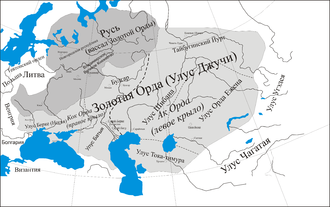 The Golden Horde and its vassals in dark grey.
The Golden Horde and its vassals in dark grey. See also: Golden Horde
See also: Golden HordeDuring the 14th century, Poland and Lithuania fought wars against the Mongol invaders, and eventually most of Ukraine passed to the rule of Poland and Lithuania. More particularly, the lands of Volynia in the north and north-west passed to the rule of Lithuanian princes, while the south-west passed to the control of Poland (Galicia) and Hungary (Zakarpattya).
Most of Ukraine bordered parts of Lithuania, and some say that the name, "Ukraine" comes from the local word for "border," although the name "Ukraine" was also used centuries earlier. Lithuania took control of the state of Volynia in northern and northwestern Ukraine, including the region around Kiev (Rus'), and the rulers of Lithuania then adopted the title of ruler of Rus'. Poland took control of the region of Galicia. Following the union between Poland and Lithuania, Poles, Germans, Armenians and Jews migrated to the region.
Polish–Lithuanian Commonwealth
See also: Nogai Horde, Muscovite Tsardom, and MoldaviaAfter the Union of Lublin in 1569 and the formation of the Polish–Lithuanian Commonwealth Ukraine fell under Polish administration, becoming part of the Crown of the Kingdom of Poland. The period immediately following the creation of the Commonwealth saw a huge revitalisation in colonisation efforts. Many new cities and villages were founded. New schools spread the ideas of the Renaissance; Polish peasants arrived in great numbers and quickly became mixed with the local population; during this time, most of Ukrainian nobles became polonised and converted to Catholicism, and while most Ruthenian-speaking peasants remained within the Eastern Orthodox Church, social tension rose.
Ruthenian peasants (Ukrainians and some from other nations) who fled efforts to force them into serfdom came to be known as Cossacks and earned a reputation for their fierce martial spirit. Some Cossacks were hired by the Commonwealth (became 'register Cossacks') as soldiers to protect the southeastern borders of Poland from Tatars or took part in campaigns abroad (like Petro Konashevych-Sahaidachny in the battle of Khotyn 1621). Cossack units were also active in wars between the Polish–Lithuanian Commonwealth and Muscovy.
Cossack era
See also: History of CossacksThe 1648 Ukrainian Cossack (Kozak) rebellion and war of independence (Khmelnytsky Uprising), which started an era known as the Ruin (in Polish history as The Deluge), undermined the foundations and stability of the Commonwealth. The nascent Cossack state, the Zaporozhian Host, usually viewed as precursor of Ukraine, found itself in a three-sided military and diplomatic rivalry with the Ottoman Turks, who controlled the Tatars to the south, the Commonwealth of Poland and Lithuania, and the rising Russia to the East.
The reconstituted Ukrainian state, having recently fought a bitter war with Poland, sought a treaty of protection with Russia in 1654. This agreement was known as the Treaty of Pereyaslav. Commonwealth authorities then sought compromise with the Ukrainian Cossack state by signing the Treaty of Hadiach in 1658, but — after thirteen years of incessant warfare — the agreement was later superseded by 1667 Polish-Russian Treaty of Andrusovo, which divided Ukrainian territory between the Commonwealth and Russia. Under Russia, the Cossacks initially retained official autonomy in the Hetmanate. For a time, they also maintained a semi-independent republic in Zaporozhia, and a colony on the Russian frontier in Sloboda Ukraine.
Russian Empire and Austro-Hungary
See also: Partitions of Poland and Little RussiaTsarist rule over central Ukraine gradually replaced 'protection' over the subsequent decades. After the Partitions of Poland in 1772, 1793 and 1795, the extreme west of Ukraine fell under the control of the Austrians, with the rest as part of the Russian Empire. As a result of Russo-Turkish Wars the Ottoman Empire's control receded from south-central Ukraine, while the rule of Hungary over the Transcarpathian region continued. Ukrainian writers and intellectuals were inspired by the nationalistic spirit stirring other European peoples existing under other imperial governments and became determined to revive the Ukrainian linguistic and cultural traditions and re-establish a Ukrainian nation-state, a movement that became known as Ukrainophilism.
Russia, fearing separatism, imposed strict limits on attempts to elevate the Ukrainian language and culture, even banning its use and study. This led to an exodus of a number of Ukrainian intellectuals into Western Ukraine. However, many Ukrainians accepted their fate in the Russian Empire and some were to achieve a great success there. Many Russian writers, composers, painters and architects of the 19th century were of Ukrainian descent. Probably the most notable were Nikolai Gogol, one of the greatest writers in the history of Russian literature, and Pyotr Ilyich Tchaikovsky, one of the greatest composers in the history of Russian music, whose father came of Ukrainian Cossack stock.
 Railway station of Fastiv before 1917, in tsarist Russia
Railway station of Fastiv before 1917, in tsarist Russia
The fate of the Ukrainians was far different under the Austrian Empire where they found themselves in the pawn position of the Russian-Austrian power struggle for the Central and Southern Europe. Unlike in Russia, most of the elite that ruled Galicia were of Austrian or Polish descent, with the Ruthenians being almost exclusively kept in peasantry. During the 19th century, Russophilia was a common occurrence among the Slavic population, but the mass exodus of Ukrainian intellectuals escaping from Russian repression in Eastern Ukraine, as well as the intervention of Austrian authorities, caused the movement to be replaced by Ukrainophilia, which would then cross-over into the Russian Empire. With the start of World War I, all those supporting Russia were rounded up and massacred by the Austrian forces at Talerhof.
First World War, the revolutions and aftermath
Main articles: Ukraine in World War I and Ukraine after the Russian RevolutionSee also: Ukrainian War of IndependenceWhen World War I and series of revolutions across the Europe including the October Revolution in Russia shattered many existing empires such as the Austrian and Russian ones, while people of Ukraine were caught in the middle. Between 1917 and 1918, several separate Ukrainian republics manifested independence, the anarchist Free Territory, the Ukrainian People's Republic, the West Ukrainian People's Republic, and numerous Bolshevik revkoms.
As the area of Ukraine fell into warfare and anarchy, it was also fought over by German and Austrian forces, the Red Army of Bolshevik Russia, the White Forces of General Denikin, the Polish Army, anarchists led by Nestor Makhno.
The defeat in the Polish-Ukrainian War and then the failure of the Piłsudski's and Petliura's Warsaw agreement of 1920 to oust the Bolsheviks during the Kiev Operation led almost to the occupation of Poland itself. In course of the new Polish-Soviet War purpose of which changed from the 1920 led to the signing of the Peace of Riga in March 1921, and after which the part of Ukraine west of Zbruch had been incorporated into Poland, and the east became part of the Soviet Union as the Ukrainian Soviet Socialist Republic.
-
A stamp of the Ukrainian People's Republic. 1918.
Interbellum
Soviet Ukraine
The Ukrainian national idea lived on during the inter-war years and was even spread to a large territory with traditionally mixed population in the east and south that became part of the Ukrainian Soviet republic. The Ukrainian culture even enjoyed a revival due to Bolshevik concessions in the early Soviet years (until early-1930s) known as the policy of Korenization ("indigenisation"). In these years, an impressive Ukrainization program was implemented throughout the republic. The rapidly developed Ukrainian language based education system dramatically raised the literacy of the Ukrainophone rural population. Simultaneously, the newly-literate ethnic Ukrainians migrated to the cities, which became rapidly largely Ukrainianised—in both population and in education. Similarly expansive was an increase in Ukrainian language publishing and overall eruption of Ukrainian cultural life.
Ukrainian SSR in 1933, after the Peace of Riga and the consolidation of USSR. Note the rose border line showing the Soviet claims over the former Russian guberniya of Bessarabia
At the same time, the usage of Ukrainian was continuously encouraged in the workplace and in the government affairs as the recruitment of indigenous cadre was implemented as part of the korenisation policies. While initially, the party and government apparatus was mostly Russian-speaking, by the end of 1920s the ethnic Ukrainians composed over one half of the membership in the Ukrainian communist party, the number strengthened by accession of Borotbists, a formerly indigenously Ukrainian "independentist" and non-Bolshevik communist party.
Despite the ongoing Soviet Union-wide antireligious campaign, the Ukrainian national Orthodox church was created called the Ukrainian Autocephalous Orthodox Church (UAOC). The Bolshevik government initially saw the national church as a tool in their goal to suppress the Russian Orthodox Church always viewed with the great suspicion by the regime for its being the cornerstone of pre-revolutionary Russian Empire and the initially strong opposition it took towards the regime change. Therefore, the government tolerated the new Ukrainian national church for some time and the UAOC gained a wide following among the Ukrainian peasantry.
The change in the Soviet economic policies towards the fast-pace industrialisation was marked by the 1928 introduction of Joseph Stalin's first piatiletka (a five-year plan). The industrialisation brought about a dramatic economic and social transformation in traditionally agricultural Ukraine. In the first piatiletkas the industrial output of Ukraine quadrupled as the republic underwent a record industrial development. The massive influx of the rural population to the industrial centres increased the urban population from 19% to 34%.
However, the industrialisation had a heavy cost for the peasantry, demographically a backbone of the Ukrainian nation. To satisfy the state's need for increased food supplies and finance industrialisation, Stalin instituted a program of collectivisation of agriculture, which profoundly affected Ukraine, often referred to as the "breadbasket of the USSR". In the late 1920s and early '30s, the state combined the peasants' lands and animals into collective farms. Starting in 1929, a policy of enforcement was applied, using regular troops and secret police to confiscate lands and materials where necessary.
Many resisted, and a desperate struggle by the peasantry against the authorities ensued. Some slaughtered their livestock rather than turn it over to the collectives. Wealthier peasants were labeled "kulaks", enemies of the state. Tens of thousands were executed and about 100,000 families were deported to Siberia and Kazakhstan.
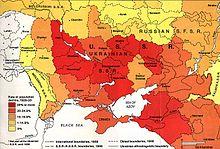 Rate of population decline in Ukraine and some regions of the USSR as a result of the Holodomor
Rate of population decline in Ukraine and some regions of the USSR as a result of the Holodomor
Note: The map was created according to the datas of the localities affected by the Holomodor and extrapolated to the post-WW2 administrative divisions. For example, in the Moldavian SSR, only Transnistria have been affected by the Holodomor. In the Odessa Oblast, the Bugeac was not affected by the Holodomor.Forced collectivisation had a devastating effect on agricultural productivity. Despite this, in 1932 the Soviet government increased Ukraine's production quotas by 44%, ensuring that they could not be met. Soviet law required that the members of a collective farm would receive no grain until government quotas were satisfied. The authorities in many instances exacted such high levels of procurement from collective farms that starvation became widespread.
The precise number of Ukrainians murdered by Stalin's custom-made famine and firing squads remains unknown to this day. The KGB's archives, and recent work by Russian historians, show at least seven million died. Ukrainian historians put the figure at nine million, or higher. Twenty-five percent of Ukraine's population was exterminated in what is known as the Holodomor or Ukrainian Holocaust.
The Soviet Union suppressed information about this genocide, and as late as the 1980s admitted only that there was some hardship because of kulak sabotage and bad weather. Today, its existence is accepted.[by whom?] Non-Soviets maintain that the famine was an avoidable, deliberate act of genocide.
The times of industrialisation and collectivisation also brought about a wide campaign against "nationalist deviation" which in Ukraine translated into an assault on the national political and cultural elite. The first wave of purges between 1929 and 1934 targeted the revolutionary generation of the party that in Ukraine included many supporters of Ukrainization. The next 1936–1938 wave of political purges eliminated much of the new political generation that replaced those that perished in the first wave and halved the membership of the Ukrainian communist party. The purged Ukrainian political leadership was largely replaced by the cadre sent from Russia that was also largely "rotated" by Stalin's purges. As the policies of Ukrainisation were halted (1931) and replaced by massive Russification approximately four-fifths of the Ukrainian cultural elite, intellectuals, writers, artists and clergy, had been "eliminated", executed or imprisoned, in the following decade.[13] Mass arrests of the hierarchy and clergy of the Ukrainian Autocephalous Orthodox Church culminated in the liquidation of the church in 1930.
Galicia and Volhynia under Polish rule
 The breaking of the siege of Lviv by Poles (November 1919) and the Polish border at the Zbruch River by the wars end, with eastern Galicia (shown in blue) under the Polish control.
The breaking of the siege of Lviv by Poles (November 1919) and the Polish border at the Zbruch River by the wars end, with eastern Galicia (shown in blue) under the Polish control. Main article: History of Poland (1918–1939)See also: Treaty of Warsaw (1920)
Main article: History of Poland (1918–1939)See also: Treaty of Warsaw (1920)Following the end of World War I, the eastern part of the former Austrian province of Galicia, as well as Volhynia, which had belonged to the Russian Empire, became the area of a Polish-Ukrainian War. The Ukrainians claimed these lands because they made up the majority of population there (except for cities, such as Lviv), while the Poles saw these provinces as Eastern Borderlands, a historical part of their country. The war was won by the Poles, and their rule over these disputed lands was cemented after another Polish victory, in the Polish-Soviet War.
In the interbellum period, eastern Galicia was divided into three administrative units — Lwów Voivodeship, Stanisławów Voivodeship, and Tarnopol Voivodeship, while in Volhynia, Wołyń Voivodeship was created. Ukrainian majority of these lands was repressed by the Polish authorities, and the conflict escalated in the 1930s, also due to terrorist actions of the Organization of Ukrainian Nationalists. The tensions were further exacerbated by arrival of thousands of osadniks, or Polish settlers, who were granted land, especially in Volhynia.
Polish rule over the provinces ended in 1939, following Nazi and Soviet attack. After Battle of Lwow, units of the Red Army entered regional capital, Lviv, and following Elections to the People's Assemblies of Western Ukraine and Western Belarus, both eastern Galicia and Volhynia were annexed by the Soviet Union.
Bukovina under Romanian rule
Main article: BukovinaTranscarpathia under Czechoslovakia and Hungary
Main articles: Carpathian Ruthenia and Carpatho-UkraineWorld War II
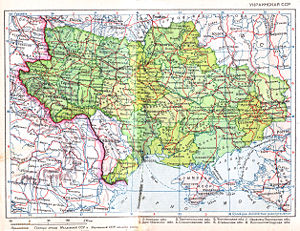 Ukrainian SSR in 1940, after the Soviet invasions of Poland and Romania and before the German invasion of Soviet Union.
Ukrainian SSR in 1940, after the Soviet invasions of Poland and Romania and before the German invasion of Soviet Union.
Following the Ribbentrop-Molotov pact, in September 1939, German and Soviet troops divided the territory of Poland, including Galicia with its Ukrainian population. Next, after France surrendered to Germany, Romania ceded Bessarabia and northern Bukovina to Soviet demands. The Ukrainian SSR incorporated northern and southern districts of Bessarabia, the northern Bukovina, and additionally the Soviet-occupied Hertsa region, but ceded the western part of the Moldavian ASSR to the newly-created Moldavian SSR. All these territorial gains were internationally recognized by the Paris Peace Treaties, 1947.
When Nazi Germany with its allies invaded the Soviet Union in 1941, many Ukrainians and Polish people, particularly in the west where they had experienced two years of harsh Soviet rule, initially regarded the Nazis as liberators. Some Ukrainian activist of the national movement hoped for a momentum to establish an independent state of Ukraine. German policies initially gave some encouragement to such hopes through the vague promises of sovereign 'Greater Ukraine' as the Germans were trying to take advantage of anti-Soviet, anti-Ukrainian, anti-Polish, and anti-Jewish sentiments.[14] A local Ukrainian auxiliary police was formed as well as Ukrainian SS division, 14th Waffen Grenadier Division of the SS Galicia (1st Ukrainian). However, after the initial period of a limited tolerance, the German policies soon abruptly changed and the Ukrainian national movement was brutally crushed.
Most Ukrainians, however, utterly resisted the Nazi onslaught from its start and a partisan movement immediately spread over the occupied territory. Some elements of the Ukrainian nationalist underground formed a Ukrainian Insurgent Army that fought both Soviet and Nazi forces. In some western regions of Ukraine, the Ukrainian Insurgent Army survived underground and continued the resistance against the Soviet authorities well into the 1950s, though many Ukrainian civilians were murdered in this conflict by both sides.
The Nazi administrators of conquered Soviet territories made little attempt to exploit the population's possible dissatisfaction with Soviet political and economic policies. Instead, the Nazis preserved the collective-farm system, systematically carried out genocidal policies against Jews, and deported many Ukrainians to forced labour in Germany. In their active resistance to Nazi Germany, the Ukrainians comprised a significant share of the Red Army and its leadership as well as the underground and resistance movements. Total civilian losses during the War and German occupation in Ukraine are estimated at seven million, including over a million Jews shot and killed by the Einsatzgruppen.
Many civilians fell victim to atrocities, forced labor, and even massacres of whole villages in reprisal for attacks against Nazi forces. Of the estimated eleven million Soviet troops who fell in battle against the Nazis, about 25% (2.7 million) were ethnic Ukrainians. Moreover, Ukraine saw some of the biggest battles of the war starting with the encirclement of Kiev (later acclaimed as a Hero City) where more than 660,000 Soviet troops were taken captive, to the fierce defence of Odessa, and on to the victorious storming across the Dnieper river.
-
German occupation of Ukraine stamp of 1941
-
Ukrainians being deported to Nazi Germany for forced labor, 1942
Post-war
After World War II some amendments to the Constitution of the Ukrainian SSR were accepted, which allowed it to act as a separate subject of international law in some cases and to a certain extent, remaining a part of the Soviet Union at the same time. In particular, these amendments allowed the Ukrainian SSR to become one of founding members of the United Nations (UN) together with the Soviet Union and the Byelorussian SSR. This was part of a deal with the United States to ensure a degree of balance in the General Assembly, which, the USSR opined, was unbalanced in favor of the Western Bloc. In its capacity as a member of the UN, the Ukrainian SSR was an elected member of the United Nations Security Council in 1948–1949 and 1984–1985.
Over the next decades, the Ukrainian republic not only surpassed pre-war levels of industry and production but also was the spearhead of Soviet power. Ukraine became the centre of Soviet arms industry and high-tech research. The republic was also turned into a Soviet military outpost in the cold war, a territory crowded by military bases packed with the most up-to-date weapons systems.
Such an important role resulted in a major influence of the local elite. Many members of the Soviet leadership came from Ukraine, most notably Nikita Khrushchev and Leonid Brezhnev a Soviet leader from 1964 to 1982, as well as many prominent Soviet sportsmen, scientists and artists. In 1954, the Russian-populated oblast of Crimea was transferred from the Russian to the Ukrainian Soviet Republic.
However, the relatively underdeveloped industrial branches such as coal- and iron ore mining, metallurgy, chemical and energy industry dominated the republic's economy. Once a Cossack steppe, the southern oblasts of Dnipropetrovsk and Zaporizhzhia were turned into a highly industrialised area with rapidly increasing impact on its environment and public health. A pursuit to energy production sufficient for growing industry led to the gigantic nature-remastering: turning the Dnieper River into a regulated system of large reservoirs.
The products of the rapidly developed high-tech industry in Ukraine were largely directed for military consumption, similarly to much of the Soviet economy, and the supply and quality of consumer goods remained low compared even to the neighboring countries of the Eastern bloc. A state-regulated system of production and consumption lead to gradual decrease of quality of life and growing "shadowisation" of retail infrastructure as well as of corruption.
The town of Pripyat, Ukraine was the site of the Chernobyl disaster, which occurred on April 26, 1986 when a nuclear plant exploded. The fallout contaminated large areas of northern Ukraine and even parts of Belarus. This spurred on a local independence movement called the Rukh that helped expedite the break-up of the Soviet Union during the late 1980s.
Independence
Kravchuk and Kuchma rule (1991–2004)
On January 21, 1990, over 300,000 Ukrainians[15] organised a human chain for Ukrainian independence between Kiev and Lviv, in memory of the 1919 unification of the Ukrainian People's Republic and the West Ukrainian National Republic. Citizens came out to the streets and highways, forming live chains by holding hands in support of unity.
Ukraine officially declared itself an independent state on August 24, 1991, when the communist Supreme Soviet (parliament) of Ukraine proclaimed that Ukraine will no longer follow the laws of USSR and only the laws of the Ukrainian SSR, de facto declaring Ukraine's independence from the Soviet Union. On December 1, Ukrainian voters overwhelmingly approved a referendum formalising independence from the Soviet Union. Over 90% of Ukrainian citizens voted for independence, with majorities in every region, including 56% in Crimea, which had a 75% ethnic Russian population. The Soviet Union formally ceased to exist on December 26, when the presidents of Ukraine, Belarus and Russia (the founding members of the USSR) met in Belovezh Pushcha to formally dissolve the Union in accordance with the Soviet Constitution. And with this Ukraine's independence was formalized de jure and recognised by the international community.
The first nation to recognize Ukraine's independence was Canada, which has the largest ethnic Ukrainian minority in the West.
The history of Ukraine between 1991 and 2004 was marked by the presidencies of Leonid Kravchuk and Leonid Kuchma. This was a time of transition for Ukraine. While it had attained nominal independence from Russia, its presidents maintained close ties with their neighbours.
On June 1, 1996, Ukraine became a non-nuclear nation when it sent the last of its 1,900 strategic nuclear warheads it had inherited from the Soviet Union to Russia for dismantling.;[16] Ukraine had committed to this by signing the Budapest Memorandum on Security Assurances in January 1994.[17]
The country adopted its constitution on June 28.
The Cassette Scandal of 2000 was one of the turning points in post-independence history of the country.
-
Leonid Kravchuk in 1992
Since the Orange Revolution (2004)
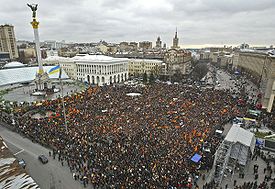 Orange-clad demonstrators gather in the Independence Square in Kiev on 22 November 2004. On some days, the number of protesters in the center of Kiev reached hundreds of thousands (one million by some estimates).
Orange-clad demonstrators gather in the Independence Square in Kiev on 22 November 2004. On some days, the number of protesters in the center of Kiev reached hundreds of thousands (one million by some estimates). Main article: Orange Revolution
Main article: Orange RevolutionIn 2004, Leonid Kuchma announced that he would not run for re-election. Two major candidates emerged in the 2004 presidential election. Viktor Yanukovych, the incumbent Prime Minister, supported by both Kuchma and by the Russian Federation, wanted closer ties with Russia. The main opposition candidate, Viktor Yushchenko, called for Ukraine to turn its attention westward and eventually join the EU. In the runoff election, Yanukovych officially won by a narrow margin, but Yushchenko and his supporters cried foul, alleging that vote rigging and intimidation cost him many votes, especially in eastern Ukraine. A political crisis erupted after the opposition started massive street protests in Kiev and other cities, and the Supreme Court of Ukraine ordered the election results null and void. A second runoff found Viktor Yushchenko the winner. Five days later, Viktor Yanukovych resigned from office and his cabinet was dismissed on January 5, 2005.
In March 2006, the Verkhovna Rada elections took place and three months later the official government was formed by the "Anti-Crisis Coalition" among the Party of Regions, Communist, and Socialist parties. The latter party switched from the "Orange Coalition" with Our Ukraine, and the Yulia Tymoshenko Bloc. The new coalition nominated Viktor Yanukovych for the post of Prime Minister. Yanukovych once again became Prime Minister, while the leader of the Socialist Party, Oleksander Moroz, managed to secure the position of chairman of parliament, which is believed by many to have been the reason for his leaving the Orange Coalition, where he had not been considered for this position.
On April 2, 2007, President Yushchenko dissolved the Verkhovna Rada because members of his party were defecting to the opposition.[18] His opponents called the move unconstitutional. When they took the matter to the Constitutional Court, Yushchenko dismissed 3 of the court's 18 judges, accusing them of corruption.
During the Yushchenko term, relations between Russia and Ukraine often appeared strained as Yushchenko looked towards improved relations with the European Union and less toward Russia. In 2005, a highly-publicized dispute over natural gas prices took place, involving Russian state-owned gas supplier Gazprom, and indirectly involving many European countries which depend on natural gas supplied by Russia through the Ukrainian pipeline. A compromise was reached in January 2006, and in early 2010 a further agreement was signed locking the price of Russian gas at $100 per 1,000 cubic meters in an exclusive arrangement.
By the time of the presidential election of 2009, Yushchenko and Tymoshenko — allies during the Orange Revolution — had become bitter enemies. Tymoshenko ran for president against both Yushchenko and Viktor Yanukovych, creating a three-way race. Yushchenko, whose popularity had plummeted, refused to close ranks and support Tymoshenko, thus dividing the anti-Yanukovych vote. Many pro-Orange voters stayed home. With less than one-third of the eligible voters going to the polls, Yanukovych received 48% of the vote and Yushchenko less than 6%, an amount which, if thrown to Tymoshenko, who received 45%, would have prevented Yanukovych from gaining the presidency. As a result Yanukovych's pro-Russia party had regained power after five years and the Orange Revolution of 2004 was halted, at least temporarily.[19]
The first 100 days of Yanukovych's term saw a tightening of press restrictions and a renewed effort in the parliament to limit freedom of assembly.[20] On 27 April 2010, a pitched battle broke out in parliament over ratification of a treaty with Russia extending the latter's naval presence in the Crimea through 2042. Members of the opposition parties, firmly against ratification, argued that a quorum was not present and therefore the treaty could not be voted upon, but the speaker continued to call the role. Two smoke grenades were set off, and opposition members threw eggs and tomatoes at the speaker, who continued to call the roll protected by bodyguards brandishing black umbrellas. Opposition party members complained bitterly that the Yanukovych party members stormed across the aisles and pressed the opposition party members' voting buttons, creating a false yes vote for the bill.[21]
-
Viktor Yushchenko with chloracne from TCDD dioxin poisoning (2006).
Historiography of Ukraine
The scholarly study of Ukraine's history emerged from romantic impulses in the late 19th century. The outstanding leaders were Volodymyr Antonovych (1834–1908), based in Kiev, and his student Michael Hrushevsky (1866–1934).[22] For the first time full-scale scholarly studies based on archival sources, modern research techniques, and modern historical theories became possible. However, the demands of government officials—especially Soviet, but also Czarists and Polish—made it difficult to disseminate ideas that ran counter to the central government. Therefore exile schools of historians emerged in central Europe and Canada after 1920.[23]
Strikingly different interpretations of the medieval state of Kievan Rus' appear in the four schools of historiography within Ukraine: Russophile, Sovietophile, Eastern Slavic, and Ukrainophile. The Sovietophile and Russophile schools have become marginalized in independent Ukraine, with the Ukrainophile school being dominant in the early 21st century. The Ukrainophile school promotes an identity that is mutually exclusive of Russia. It has come to dominate the nation's educational system, security forces, and national symbols and monuments, although it has been dismissed as nationalist by Western historians. The East Slavic school, an eclectic compromise between Ukrainophiles and Russophilism, has a weaker ideological and symbolic base, although it is preferred by Ukraine's centrist former elites.[24]
Many historians in recent years have sought alternatives to national histories, and Ukrainian history invited approaches that looked beyond a national paradigm. Multiethnic history recognizes the numerous peoples in Ukraine; transnational history portrays Ukraine as a border zone for various empires; and area studies categorizes Ukraine as part of Eurasia, or more often as part of East-Central Europe. Plokhy (2007) argues that looking beyond the country's national history has made possible a richer understanding of Ukraine, its people, and the surrounding regions.[25]
After 1991, historical memory was a powerful tool in the political mobilization and legitimation of the post-Soviet Ukrainian state, as well as the division of selectively used memory along the lines of the political division of Ukrainian society. Ukraine did not experience the restorationist paradigm typical of some other post-Soviet nations, including the Baltic states, although the multifaceted history of independence, the Orthodox Church in Ukraine, Soviet-era repressions, mass famine, and World War II collaboration were used to provide a different constitutive frame for the new Ukrainian nation. The politics of identity (which includes the production of history textbooks and the authorization of commemorative practices) has remained fragmented and tailored to reflect the ideological anxieties and concerns of individual regions of Ukraine.[26]
Historical maps of Ukraine
The Ukrainian state has occupied a number of territories since its initial foundation. Most of these territories have been located within Eastern Europe, however, as depicted in the maps in the gallery below, has also at times extended well into Eurasia and southeastern Europe. At times there has also been a distinct lack of a Ukrainian state, as its territories were on a number of occasions, annexed by its more powerful neighbours.
Historical Maps of Ukraine and its Predecessors Territory of Slavic peoples (6th century).European territory inahibted by East Slavic tribes in 8th and 9th century.Early formation of Kievan Rus' (862–912): Territory of rulers Askold, Dyr and Oleh of Novgorod.Gallery of Historical map of Kievan Rus' at its zenith (980–1054).Historical map of Kievan Rus' and territory of Ukraine: last 20 years of the state (1220–1240).The Kingdom of Galicia–Volhynia or Kingdom of Halych-Volynia (1245–1349).Historical map of Grand Duchy of Lithuania, Rus' (Ukraine) and Samogitia until 1434.Historical map of Cossack Hetmanate, also known as Hetmanate of Zaporizhian Host or Ukrainian Cossack state (1649–1653).Polish–Lithuanian–Ruthenian Commonwealth or Commonwealth of Three Nations (1658).Historical map of Ukrainian Cossack Hetmanate and territory of Zaporozhian Cossacks under rule of Russian Empire (1751).Historical map of Ukrainian National Republic or Ukrainian People's Republic (1917–1920).Bibliography
- Encyclopedia of Ukraine (University of Toronto Press, 1984–93) 5 vol; from Canadian Institute of Ukrainian Studies, partly online
- Ukraine: A Concise Encyclopedia. ed by Volodymyr E. KubijovyČ; University of Toronto Press. 1963; 1188pp online at Questia
- Kohut, Zenon E.; Nebesio, Bohdan Y.; and Yurkevich, Myroslav. Historical Dictionary of Ukraine. (2005). 854 pp.
- Aslund, Anders, and Michael McFaul.Revolution in Orange: The Origins of Ukraine's Democratic Breakthrough (2006)
- Brandon, Ray, and Wendy Lower, eds. The Shoah in Ukraine: History, Testimony, Memorialization. (2008). 378 pp. online review
- Berkhoff, Karel C. Harvest of Despair: Life and Death in Ukraine Under Nazi Rule. (2004). 448 pp.
- D'Anieri, Paul, et al. Politics and Society in Ukraine (1999) online edition
- Dimarov, Anatoliy et al. A Hunger Most Cruel: The Human Face of the 1932–1933 Terror-Famine in Soviet Ukraine (2002) excerpt and text search
- Gross, Jan T. Revolution from Abroad: The Soviet Conquest of Poland's Western Ukraine and Western Belorussia (1988).
- Mykhailo Hrushevsky. A History of Ukraine (1986)
- Mykhailo Hrushevsky. History of Ukraine-Rus' in 9 volumes. Selected volumes translated into English. Available online in Ukrainian as "Історія України-Руси".
- Askold Krushelnycky. An Orange Revolution: A Personal Journey Through Ukrainian History. (2006). ISBN 0-436-20623-4. 320 pages.
- Kubicek, Paul. The History of Ukraine (2008) excerpt and text search
- Kuzio, Taras. Ukraine: State and Nation Building (1998) online edition
- Luckyj, George S. Literary Politics in the Soviet Ukraine, 1917–1934 (1990). online edition
- Lower, Wendy. Nazi Empire-Building and the Holocaust in Ukraine. U. of North Carolina Press, 2005. 307 pp.
- Paul Robert Magocsi. A History of Ukraine. Toronto: University of Toronto Press (1996) ISBN 0-8020-0830-5.
- Plokhy, Serhii. The Cossacks and Religion in Early Modern Ukraine (2001) online edition
- Redlich, Shimon. Together and Apart in Brzezany: Poles, Jews, and Ukrainians, 1919–1945. Indiana U. Press, 2002. 202 pp.
- Reid, Anna. Borderland: A Journey Through the History of Ukraine (2003) online edition
- Subtelny, Orest (2009). Ukraine: A History. Toronto: University of Toronto Press. ISBN 0802083900. A Ukrainian translation navailable online.
- Wanner, Catherine. Burden of Dreams: History and Identity in Post-Soviet Ukraine (1998) excerpt and text search
- Andrew Wilson. The Ukrainians: Unexpected Nation. Yale University Press; 2nd edition (2002) ISBN 0-300-09309-8.
- Yekelchyk, Serhy (2007). Ukraine: Birth of a Modern Nation. Oxford University Press. ISBN 978-0-19-530545-6.
- Zabarko, Boris, ed. Holocaust in the Ukraine. Vallentine Mitchell, 2005. 394 pp.
- Abridged History of Ukraine at Portals of the World: Ukraine project by the Library of Congress
Primary sources in English
- Luckyj, George S. Towards an Intellectual History of Ukraine: An Anthology of Ukrainian Thought from 1710 to 1995. (1996)
Ukrainian
- Essays on History on Ukraine
- Volume 1 by Natalia Yakovenko, "From the Earliest Times until the End of the 18th Century"
- Volume 2: Ярослав Грицак (Yaroslav Hrytsak) (1996). Формування модерної української нації XIX-XX ст. (Formation of the Modern Ukrainian Nation in the late 19th–20th centuries). Kiev: Генеза (Heneza). ISBN 966-504-150-9.. Available online.
- Mykhailo Hrushevsky. Illustrated History of Ukraine (1913). Available online
- I. Krypiakevych. "History of Ukraine
- Handbook on the History of Ukraine
- "Ukraine: Briefly about Her Past and Present", in Welcome to Ukraine, 2003, 1.
- Polons'ka-Vasylenko, Natalia. History of Ukraine in two volumes. Available online.
- Alexander F. Tsvirkun History of Ukraine.7 class electronic textbooks. Kiev., 2005 (co-authored with Valentin A.Savelii)
- Alexander F. Tsvirkun E-learning course. History of Ukraine. Journal Auditorium, Kiev 2010
See also
- Crimean Khanate
- Dissolution of the Soviet Union
- History of Christianity in Ukraine
- History of Belarus
- History of Germany
- History of Lithuania
- History of Poland
- History of Russia
- History of Turkey
- History of the Soviet Union
- History of the Soviet Union (1927–1953)
- History of the Soviet Union (1953–1964)
- History of the Soviet Union (1964–1982)
- History of the Soviet Union (1982–1991)
- Kievan Rus
- List of Ukrainian rulers
- Politics of Ukraine
- Ruthenia
- Ukrainian language
References
- ^ Matossian Shaping World History p. 43
- ^ "What We Theorize – When and Where Did Domestication Occur". International Museum of the Horse. http://imh.org/legacy-of-the-horse/what-we-theorize-when-and-where-did-domestication-occur/. Retrieved 2010-12-12.
- ^ "Horsey-aeology, Binary Black Holes, Tracking Red Tides, Fish Re-evolution, Walk Like a Man, Fact or Fiction". Quirks and Quarks Podcast with Bob Macdonald (CBC Radio). 2009-03-07. http://www.cbc.ca/quirks/episode/2009/03/07/horsey-aeology-binary-black-holes-tracking-red-tides-fish-re-evolution-walk-like-a-man-fact-or-ficti/. Retrieved 2010-09-18.
- ^ Prat, Sandrine; Péan, Stéphane C.; Crépin, Laurent; Drucker, Dorothée G.; Puaud, Simon J.; Valladas, Hélène; Lázničková-Galetová, Martina; van der Plicht, Johannes et al. (17 June 2011). "The Oldest Anatomically Modern Humans from Far Southeast Europe: Direct Dating, Culture and Behavior". plosone. http://www.plosone.org/article/info:doi/10.1371/journal.pone.0020834. Retrieved 21 June 2011.
- ^ Carpenter, Jennifer (20 June 2011). "Early human fossils unearthed in Ukraine". BBC. http://www.bbc.co.uk/news/science-environment-13846262. Retrieved 21 June 2011.
- ^ "Trypillian Civilization 5,508 – 2,750 BC". The Trypillia-USA-Project. http://www.bank.gov.ua/ENGL/Macro/index.htm. Retrieved 2007-12-16.
- ^ "Scythian". Encyclopædia Britannica. http://www.britannica.com/eb/article-9066426. Retrieved 2007-09-12.
- ^ a b Magocsi, Paul Robert (1996). A History of Ukraine. Toronto: University of Toronto Press. p. 27. ISBN 0-8020-0830-5.
- ^ Україна (назва)
- ^ Name of Ukraine
- ^ Історичні назви українських територій
- ^ "Ukrainian Tribal Divisions and Ethnographic Groups". Home.swipnet.se. http://home.swipnet.se/roland/mongols.html. Retrieved 2011-01-30.
- ^ Encyclopædia Britannica, Ukraine article, page 51.
- ^ Luciuk, Lubomyr Y. (2000). Searching for place: Ukrainian displaced persons, Canada, and the migration of memory. University of Toronto Press. p. 125. ISBN 0-8020-4245-7. http://books.google.com/books?ie=UTF-8&vid=ISBN080208088X&id=6srpcaGeuvcC&pg=PA125&lpg=PA125&dq=ukrainians+under+germans&sig=OTTMYCLmt0qe9mtdMFqPUPVKRYM#v=onepage&q=ukrainians%20under%20germans&f=false.
- ^ Subtelny, Orest (2000). Ukraine: A History. University of Toronto Press. p. 576. ISBN 0-8020-8390-0.
- ^ Power versus Prudence: Why Nations Forgo Nuclear Weapons by T. V. Paul, McGill-Queen's University Press, 2000, ISBN 978-0773520875, page 117
- ^ Tactical Nuclear Weapons: Emergent Threats in an Evolving Security Environment by Brian Alexander, Brassey's US, 2003, ISBN 978-1574885859, page 139
- ^ Steven Lee Myers Published: May 31, 2007, Confusion, chaos and comedy in Ukrainian politics International Herlad Tribune
- ^ Appleseed Democracy Documentary interview with Ukrainian journalist Svyatoslav Tsegolko 7 July 2010
- ^ Appleseed Democracy Documentary interview with Ukrainian MP Andriy Schevchenko 6 July 2010
- ^ Fists fly in Ukraine parliament punch up April 27, 2010 CNN.com
- ^ Serhii Plokhy, Unmaking Imperial Russia: Mykhailo Hrushevsky and the Writing of Ukrainian History (2005)
- ^ KubijovyČ, ed. Ukraine: A Concise Encyclopedia (1963) 1:559-74
- ^ Taras Kuzio, "National Identity and History Writing in Ukraine," Nationalities Papers 2006 34(4): 407–427, online in EBSCO
- ^ Serhii Plokhy, "Beyond Nationality" Ab Imperio 2007 (4): 25–46,
- ^ See Andryi Portnov, "Exercises with history Ukrainian style (notes on public aspects of history's functioning in post-Soviet Ukraine)," Ab Imperio 2007 (3): 93–138, in Ukrainian
External links
- Ukrainian history overview published in Den'.
- The Holocaust by bullets, the Jewish victims of the Einsatzgruppen in Eastern Europe Yahad In Unum
History of Europe Prehistoric Europe Classical Antiquity Classical Greece · Roman Republic · Hellenistic period · Roman Empire · Late Antiquity · Early Christianity · Crisis of the 3rd century · Fall of the Roman EmpireMiddle Ages Early Middle Ages · Migration Period · Byzantine Empire · Christianization · Kievan Rus · High Middle Ages · Holy Roman Empire · Crusades · Feudalism · Late Middle Ages · Hundred Years' War · RenaissanceEarly Modern Europe Reformation · Age of Discovery · Baroque · Thirty Years' War · Absolutism · Ottoman Empire · Portuguese Empire · Spanish Empire · Early modern France · Polish–Lithuanian Commonwealth · Swedish Empire · Dutch Republic · British Empire · Habsburg Empire · Russian EmpireModern history See also History of Europe by country Sovereign
states- Albania
- Andorra
- Armenia
- Austria
- Azerbaijan
- Belarus
- Belgium
- Bosnia and Herzegovina
- Bulgaria
- Croatia
- Cyprus
- Czech Republic
- Denmark
- Estonia
- Finland
- France
- Georgia
- Germany
- Greece
- Hungary
- Iceland
- Ireland
- Italy
- Kazakhstan
- Latvia
- Liechtenstein
- Lithuania
- Luxembourg
- Macedonia
- Malta
- Moldova
- Monaco
- Montenegro
- Netherlands
- Norway
- Poland
- Portugal
- Romania
- Russia
- San Marino
- Serbia
- Slovakia
- Slovenia
- Spain
- Sweden
- Switzerland
- Turkey
- Ukraine
- United Kingdom
- (England
- Northern Ireland
- Scotland
- Wales)
- Vatican City
States with limited
recognition- Abkhazia
- Kosovo
- Nagorno-Karabakh
- Northern Cyprus
- South Ossetia
- Transnistria
Dependencies
and other territories- Åland
- Faroe Islands
- Gibraltar
- Guernsey
- Jan Mayen
- Jersey
- Isle of Man
- Svalbard
Other entities - European Union
- Sovereign Military Order of Malta
Categories:- History of Ukraine
- Ukrainian studies
- History of Austria-Hungary
Wikimedia Foundation. 2010.

